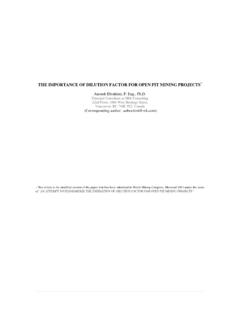Transcription of Exploration Geology - SRK
1 1 Measuring the effectiveness of geological Exploration and looking for trends that will lead to improved Exploration success are key drivers for continued investment in the Exploration for mineral deposits global trendsNo. 47 SRK Consulting sInternational NewsletterExpenditure on Exploration in Australia, for example, reached a peak in 2008, which reflects a massive increase in Exploration for iron ore resources and, to a lesser extent, coal resources. The correction after the global financial crisis in late 2008 resulted in a significant drop in 2009 up to 42% globally, most of which was recovered in non-ferrous mineral Exploration expenditures in Australian Bureau of Statistics report on current trends shows continuing strength, but the return on expenditure on new deposits has been disappointing. Geoscience Australia identifies only one gold discovery, three base metal discoveries and one molybdenum discovery from decreasing discovery rate is reflected in Australia strongly focused on brownfields drilling, with 63% of expenditure on those targets.
2 While the latest trends show a slight increase in greenfields Exploration , the overall trend shows a continuing focus on areas with a higher probability of success. With respect to greenfield Exploration , the industry is moving from a phase of discovery of near-surface deposits to generating methods for discovery of deposits at depth, either below an unconformity or within a basement terrane, but with no exposure at surface..continuedStanding on an undeveloped iron ore deposit, Pilbara, WA, with the Brockman Formation forming the Hamersley Ranges in the backgroundnewsExploration Geology2 Exploration for mineral deposits (continued)Both areas present significant Exploration challenges if the cost of discovery is to remain within economic remains at the forefront of providing high-quality support to Exploration companies active in both brownfields and greenfields Exploration .
3 Search for deep or buried deposits relies on Exploration targeting from geophysical datasets or specialised geochemical datasets by applying quality structural Geology to geological interpretation of them. Geological analysis remains a key component of greenfields Exploration support, and detailed mapping and advanced visualisation of structural data applied to brownfields or resource expansion projects can add significantly to success. Particularly in brownfields, advances in 3D modelling significantly enhance the probability of success and capability in designing drill programs based on geophysical and structural targets. Applying new modelling and visualisation techniques is at the core of this newsletter provides case studies where SRK has contributed significantly, delivering discovery efficiently and improving Exploration success in an Exploration environment that is increasingly technically Williams: PEtEr WilliamsPeter has over 40 years experience in the minerals industry, including 18 years as a consultant on a range of projects from project reviews and audits and public reporting, to structural studies on both a regional and orebody scale.
4 He has conducted major interpretation projects from aeromagnetic data for Exploration targeting, and has worked in a range of geological terranes in Australia, West Africa, East Africa, Zimbabwe, Zambia, Democratic Republic of Congo, Indonesia, Papua New Guinea, Vanuatu, Solomon Islands and Williams: and Exploration in Indonesia present challenges that are technical, legal and social in nature. The country is currently developing regulations for its new mining law, so there is some uncertainty, albeit within a well-defined legal provides numerous opportunities for Exploration , and SRK is currently involved in several major projects there, mainly concerned with preparing JORC resource statements on coal, gold, laterite nickel and copper deposits. This active tectonic environment with volcanic arcs from the Cretaceaous to Recent periods overlying Late Paleozoic to Mesozoic basement rocks, contain some world class Minerals Corporation recently engaged SRK Indonesia to assess the potential of small manganese deposits in Nusa Tengara Timor (NTT) in West Timor to feed a proposed new, local processing facility to comply with the new mining law.
5 This will require a resource of about million tonnes. *Mineral Exploration Seasonally adjusted and trend series*Metres Drilled Original series* Source: Australian Bureau of Statistics, September 2011 New depositsExisting deposits2000150010005000 Jun2003 Jun2005 Jun2007 Jun2009 Jun2011 Seasonally AdjustedTrend$m10008006004002000 Jun2003 Jun2005 Jun2007 Jun2009 Jun20113indonesia Exploration on the cusp of developmentTypical bedded manganese deposit and artisanal extraction techniques, West Timor (above); Massive chert manganese breccia deposits, unconformity related, with local owners, West Timor (left)employed and where geometry is either known or can be reasonably inferred. The results from testing these techniques will guide future program will continue its involvement through field reviews, regular Exploration program audits, and assessment of Exploration a 2-day workshop, Asia Minerals Corporation learned about the key data collection required to assess current Exploration areas and generate Exploration models, adopted a methodology to assess the entire eastern NTT region for Exploration potential, and an immediate program to assess its current development licence for preliminary resource estimation.
6 In the process, it gained a committed team aware of the different components that an Exploration program needed and the inter-relationships that deliver Exploration Williams: opportunity is significant; there are more than 50 known manganese sites in NTT, where the ore is currently extracted by artisanal mining techniques and exported as unprocessed individual deposits are small, spread across extensive areas. Several economically-viable, near-surface deposits are commonly pursued concurrently to provide sufficient tonnes for processing. The advantage is that deposits are generally high-grade with low key to discovering and exploiting such deposit fields is in understanding the deposit genesis for targeting, and following a disciplined Exploration methodology. In Timor, the deposits are located in sedimentary rock deposited on the seafloor, subsequently displaced across the region, with numerous thrust faults and remnant mud volcanoes.
7 Currently, there is no model of seafloor manganese deposits that fits well with the Timor Exploration skillsIn collaboration with geologists from Asia Minerals Corporation and other advisors, SRK hosted a workshop in Jakarta to advance the understanding of manganese deposits and generate an Exploration program that would address the physical and climatic aspects of NTT in West Timor and provide the highest probability of success in defining manganese deposits to about 50m depth along strike from known workshop identified and mapped those occurrences, and prioritised them for field inspection. The mapping program outlined criteria and methods to determine the characteristics of the deposits and to help develop a genetic model for NTT manganese. It identified remote sensing requirements, geophysical methods, including potential field and active electrical methods, and geochemical methods.
8 The group defined a test area currently accessible under Exploration licence, where these techniques can be 4structural Geology collaboration results in new find for sumitomoLiese Zone4021 East DeepGold mineralisation at Pogo is hosted within the structurally controlled Liese vein system. Overall, the Liese vein system dips shallowly northwest and is a stacked system of three laminated veins (L1, L2, and L3). SRK and Sumitomo recognised that the lateral extent of the Liese vein system is large, with the L1 vein currently known to have a down-dip extent of greater than 1700 metres. The northeast margin of the Liese vein system is truncated by a post-mineralisation diorite (about 95 million years old). The crosscutting nature of the diorite, combined with the lateral extent of the vein system, indicated to SRK and Sumitomo that the vein system may extend beyond the northeast margin of the diorite, representing a significant Exploration target in the shadow of the existing 2011, Sumitomo began underground and surface drilling examining the potential for vein systems northeast of the diorite and have since outlined a significant new gold zone, the East Deep zone.
9 The East Deep zone represents In March 2010, Sumitomo Metal Mining Pogo LLC (Sumitomo) commissioned SRK Consulting Canada to undertake a structural Geology interpretation of the Pogo district in central Alaska, to assist ongoing Exploration targeting. The interpretation was focused on compiling a structural Geology interpretation of recently acquired geophysical data, combined with staged site visits, to examine the structural Geology of the Pogo deposit and collaborate with the Sumitomo Exploration team. The Pogo deposit is Alaska s largest producing gold mine. It is underlain by high-grade gneisses of the Late Proterozoic to mid-Paleozoic Yukon-Tanana terrane, which have been intruded by granitoid bodies, mostly belonging to a voluminous mid-Cretaceous suite. The Yukon-Tanana terrane and Cretaceous intrusions extend from west of Fairbanks through the central Yukon, for a distance of over 700 kilometres.
10 JamEs siddornJames Siddorn, , is a Practice Leader in Structural Geology , based in SRK s Toronto office. He is a specialist in the structural analysis of ore deposits, focused on deciphering the deposit-scale controls on ore plunge, geotechnical domains, and hydrogeological pathways. James is an expert in the applied geological interpretation of aeromagnetic data, with extensive underground and surface mapping experience, and broad mining experience in conventional and mechanised underground mining. He has spent 17 years in the structural analysis and 3D geological modelling of gold, magmatic sulfide, silver, uranium, tantalum, and diamond deposits covering different geological terranes worldwide. James has taught more than 20 Applied Structural Geology courses worldwide, to over 1000 geologists, geophysicists, and Siddorn: August 2010, Canteras Del Hallazgo , (CDH) a joint venture between Gold Fields Ltd.






